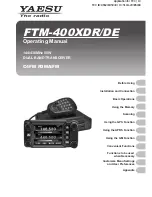
Page 22 of 90
CCT24
2.12.2 Tree-Routing System Networks
A CCT24 tree-routing system consists of one base and up to 63 routers, where the base and each router
can forward messages to/from a total of 126 child radios (leases enabled)
1
. A child radio can be either a
remote or router, within the system limitation of 63 routers total.
Within a CCT24 tree-routing system, a network refers to a group of radios communicating with a router or
base acting as a parent, and all of the child radios that are linked to this parent. Hop-by-hop, a router
alternates from being a child of its parent network on one hopping pattern to being a parent of its own
network on a different hopping pattern.
The base maintains a routing table that describes the organization of all routers in its system. This table is
used by the base and the routers to determine which direction, up to the base, or down to its children, to
route a packet. The base updates the routing table using information in the heartbeat packets it receives
from the routers in its system. The base periodically broadcasts this routing table to inform all system
radios of the current system configuration. All heartbeat packets received by the base are also output to
its host (PC). The default channel access for tree-routing systems is CSMA (mode 1).
2.12.3 Tree-Routing System Addressing
Except for tree-routing systems, CCT24 remotes are addressed from the base using their three-byte
hardware
MAC addresses
. In turn, remotes address the base using the address 0x000000, rather than
the base radio’s hardware MAC address. In tree-routing systems, however, radios are addressed using
system addresses
rather than their hardware MAC addresses. Much of the planning and commissioning
activities for a CCT24 system involve configuring system addresses.
Like MAC addresses, tree-routing system addresses contain three bytes. However, the most significant
byte of a system address is currently unused and can be assigned any value (typically 0xFF). The middle
byte of a system address is the network ID or
NwkID
of a base or router. The
NwkID
is always 0x00 for
the base, and will have a value in the range of 0x01 to 0x3F for a router. The least significant byte of the
system address is called the network address or
NwkAddr
. The
NwkAddr
is always 0x00 for the base and
all the routers in a system. For a remote, the
NwkAddr
will have a value in the range of 0x01 to 0x7E, so
the system address of a remote will contain the
NwkID
of its parent base or router, plus its own
NwkAddr
.
Several parameters are involved in the formation of a CCT24 tree-routing system. All radios that will
become part of a tree-routing system must set the
TreeRouteEn
parameter to 0x01. Further, all radios
must be loaded with the same tree-routing system ID parameter, referred to as the
TreeRouteSysID
. This
parameter allows systems to physically overlap without ambiguity as to which system a radio should join.
When a CCT24 radio is configured as the base, it automatically assumes a
NwkID
of 0x00 and
NwkAddr
of 0x00. When a radio is configured as a router, it automatically assumes a
NwkAddr
of 0x00. The rout-
er’s
NwkID
byte is held in its
BaseModeNetID
parameter, and will have value in the range of 0x01 to
0x3F. The
BaseModeNetID
parameter must be manually set in all routers. As discussed below, when a
router’s addressing is totally manually configured, the remote-mode
NwkAddr
(network address) is loaded
from a router’s
StaticNetAddress
parameter, otherwise the default value 0xFF of the parameter should be
preserved to allow dynamic assignment by the router’s parent.
1. Tree-routing systems can run without leases enabled to remove the 126 child limit on the base and routers in some circumstanc-
es. However, this takes special system planning. Contact RFM technical support for details.
















































